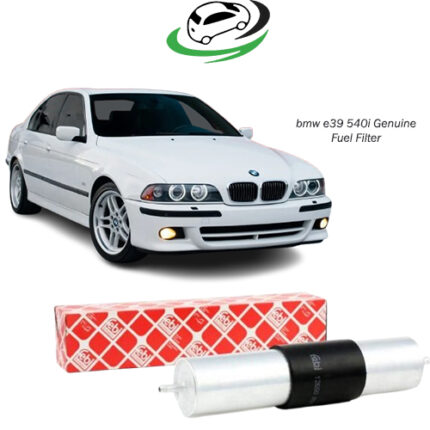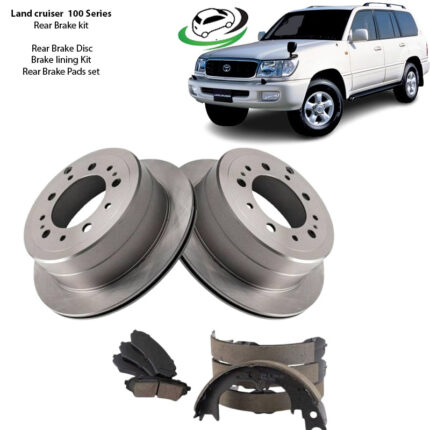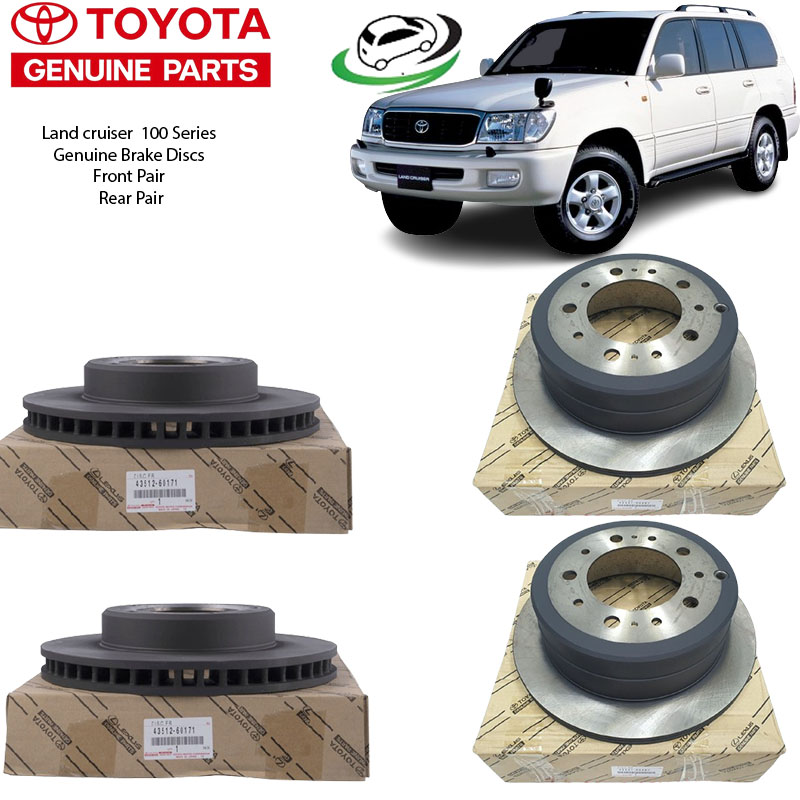-2%
Get Toyota Landcruiser 100 Series Front & Rear Pair of Brake Discs 43512-60171/ 42431-60280
The Toyota Landcruiser 100 Series is renowned for its durability, off-road capability, and robust design. As with any vehicle, maintaining its braking system is crucial for both safety and performance. One of the most critical components of this system is the brake discs (or rotors), which work together with the brake pads to bring the vehicle to a stop. This comprehensive guide will cover everything you need to know about the front and rear pair of brake discs for the Toyota Landcruiser 100 Series, including their function, benefits, signs of wear, replacement tips, and why using high-quality discs is essential for vehicle performance.
What are Brake Discs?
Brake discs, also known as rotors, are circular metal components that are attached to the wheel hub and rotate with the wheels. When you apply the brakes, the brake pads clamp down on the discs, creating friction that slows the rotation of the wheels, ultimately bringing the vehicle to a stop. In the Toyota Landcruiser 100 Series, both the front and rear wheels are equipped with brake discs, which are designed to handle the vehicle’s weight and off-road demands.
Brake discs are typically made from cast iron or composite materials like carbon or ceramic. The design of the discs can vary depending on the specific model and driving conditions, but they generally feature a smooth or ventilated surface that allows for efficient heat dissipation and even braking performance.
Function of Brake Discs
The primary function of brake discs is to convert the kinetic energy of the moving vehicle into thermal energy through friction. When the brake pedal is pressed, hydraulic pressure forces the brake pads against the discs, creating resistance that slows down the wheels.
1. Friction and Heat Dissipation: Brake discs are designed to withstand high levels of heat generated during braking. Ventilated discs, in particular, feature internal cooling vanes that help dissipate heat more effectively, reducing the risk of brake fade, which occurs when the brakes overheat and lose efficiency.
2. Consistent Braking Power: Brake discs ensure that the braking force is distributed evenly across the surface, allowing for smooth and predictable stopping power. This is especially important for the Toyota Landcruiser 100 Series, which often carries heavy loads and operates in rugged conditions where reliable braking is essential.
3. Wear Resistance: High-quality brake discs are engineered to resist wear and maintain their structural integrity even under extreme conditions. This is vital for off-road vehicles like the Landcruiser, where the braking system is subjected to more stress compared to regular on-road vehicles.
Types of Brake Discs for the Toyota Landcruiser 100 Series
The Toyota Landcruiser 100 Series comes equipped with ventilated brake discs for both the front and rear wheels. These ventilated discs are designed to improve cooling and prevent overheating, which is crucial for maintaining braking performance during heavy-duty driving, towing, or off-road use. Let’s take a closer look at the different types of brake discs:
1. Solid Brake Discs: Solid discs are typically used on lighter vehicles or rear wheels where less braking force is required. They are more cost-effective but may not provide the same level of heat dissipation as ventilated discs.
2. Ventilated Brake Discs: These discs feature internal cooling vanes that allow air to circulate between the two disc surfaces, helping to reduce heat buildup during braking. Ventilated discs are ideal for the Toyota Landcruiser 100 Series due to their ability to handle higher temperatures generated by the vehicle’s heavy weight and off-road driving conditions.
3. Slotted and Drilled Brake Discs: Some aftermarket options include slotted or drilled discs, which offer enhanced braking performance by allowing gas, water, and debris to escape more easily. These discs are often used in performance or off-road applications, but they can wear down brake pads more quickly due to their aggressive design.
Benefits of High-Quality Brake Discs
Investing in high-quality brake discs for your Toyota Landcruiser 100 Series provides several benefits that directly affect your vehicle’s safety, performance, and longevity.
1. Improved Stopping Power
High-quality brake discs provide superior stopping power, which is crucial for a vehicle like the Toyota Landcruiser 100 Series that is often driven in challenging conditions. Whether you’re towing heavy loads, driving on steep inclines, or navigating rough terrains, reliable braking performance ensures you can stop the vehicle quickly and safely.
2. Better Heat Management
Ventilated brake discs are designed to dissipate heat more effectively, preventing overheating and reducing the risk of brake fade. This is especially important for off-road driving, where the brakes are subjected to constant use, and for heavy-duty applications like towing.
3. Enhanced Durability
Brake discs made from high-quality materials like cast iron or carbon composites are more resistant to wear and tear, ensuring a longer lifespan. This durability is essential for the Landcruiser, which is often exposed to harsh environments that can accelerate brake wear.
4. Reduced Vibration and Noise
Poor-quality brake discs can cause vibration or noise during braking, leading to an uncomfortable driving experience. High-quality discs are precisely machined to minimize vibrations and ensure smooth braking, even at high speeds or under heavy loads.
5. Consistent Performance
High-quality brake discs offer consistent braking performance over time, providing peace of mind knowing that your vehicle will perform reliably in all conditions. Whether you’re driving on the highway or off-road, you can count on your brakes to deliver the stopping power you need.
Signs of Worn Brake Discs
Like all automotive components, brake discs wear down over time and need to be replaced to maintain safe and efficient braking performance. Here are some common signs that the brake discs on your Toyota Landcruiser 100 Series may need replacement:
1. Squealing or Grinding Noises
One of the most common signs of worn brake discs is a squealing or grinding noise when applying the brakes. This noise is often caused by metal-on-metal contact between the brake pads and the discs, indicating that the discs have become too thin or are damaged.
2. Vibration in the Steering Wheel
If you feel a vibration or pulsing sensation in the steering wheel when braking, it could be a sign that the brake discs are warped or unevenly worn. Warped discs can result from excessive heat or improper installation and should be replaced to prevent further damage.
3. Increased Stopping Distance
If your vehicle takes longer to come to a stop, it may indicate that the brake discs are worn and no longer providing optimal friction. This can be particularly dangerous in emergency situations where quick stopping is essential.
4. Visible Damage or Scoring
Inspecting the brake discs for visible signs of wear, such as deep grooves or scoring, can help identify when they need replacement. Excessive damage can compromise the discs’ ability to provide smooth and effective braking.
5. Brake Warning Light
Some modern vehicles are equipped with brake wear sensors that trigger a warning light on the dashboard when the brake discs or pads are worn down. If this light comes on, it’s a clear indication that it’s time to inspect and possibly replace your brake components.
Maintenance and Replacement Tips
Proper maintenance of your brake discs can extend their lifespan and ensure consistent braking performance. Here are some essential tips for maintaining and replacing the brake discs on your Toyota Landcruiser 100 Series:
1. Regular Inspections
It’s important to inspect the brake discs regularly, especially if you frequently drive off-road or tow heavy loads. Check for signs of wear, such as scoring, cracks, or uneven surfaces, and replace the discs if necessary.
2. Replace Brake Pads and Discs Together
When replacing the brake discs, it’s a good idea to replace the brake pads at the same time. Worn brake pads can damage new discs, leading to uneven wear and reducing the lifespan of both components.
3. Use Genuine or High-Quality Aftermarket Parts
Always opt for genuine Toyota brake discs or high-quality aftermarket options designed specifically for the Landcruiser 100 Series. Using substandard parts can compromise safety and performance, and may result in more frequent replacements.
4. Follow the Manufacturer’s Recommendations
Refer to the Toyota owner’s manual for recommended brake disc replacement intervals and maintenance procedures. Following the manufacturer’s guidelines ensures that your vehicle remains in optimal condition and that the braking system functions as intended.
5. Professional Installation
While brake disc replacement can be a DIY task for experienced mechanics, it’s recommended to have the job done by a professional to ensure proper installation. Incorrectly installed discs can lead to uneven wear, reduced braking efficiency, or even brake failure.
Conclusion
The Toyota Landcruiser 100 Series Front & Rear Pair of Brake Discs are vital components of the vehicle’s braking system, designed to handle the heavy demands of off-road driving, towing, and everyday use. By investing in high-quality brake discs and performing regular maintenance, you can ensure your Landcruiser delivers reliable and safe braking performance for years to come. Whether you’re navigating rough terrain or cruising on the highway, maintaining your brake discs is essential for your safety and the overall performance of your vehicle.
Follow us on Facebook for more parts.




Reviews
Clear filtersThere are no reviews yet.